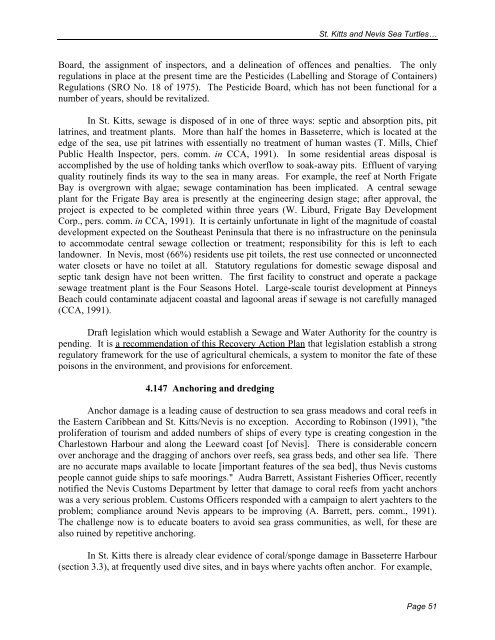Sea Turtle Recovery Action Plan for St. Kitts and Nevis - WIDECAST
Sea Turtle Recovery Action Plan for St. Kitts and Nevis - WIDECAST
Sea Turtle Recovery Action Plan for St. Kitts and Nevis - WIDECAST
You also want an ePaper? Increase the reach of your titles
YUMPU automatically turns print PDFs into web optimized ePapers that Google loves.
<strong>St</strong>. <strong>Kitts</strong> <strong>and</strong> <strong>Nevis</strong> <strong>Sea</strong> <strong>Turtle</strong>s…<br />
Board, the assignment of inspectors, <strong>and</strong> a delineation of offences <strong>and</strong> penalties. The only<br />
regulations in place at the present time are the Pesticides (Labelling <strong>and</strong> <strong>St</strong>orage of Containers)<br />
Regulations (SRO No. 18 of 1975). The Pesticide Board, which has not been functional <strong>for</strong> a<br />
number of years, should be revitalized.<br />
In <strong>St</strong>. <strong>Kitts</strong>, sewage is disposed of in one of three ways: septic <strong>and</strong> absorption pits, pit<br />
latrines, <strong>and</strong> treatment plants. More than half the homes in Basseterre, which is located at the<br />
edge of the sea, use pit latrines with essentially no treatment of human wastes (T. Mills, Chief<br />
Public Health Inspector, pers. comm. in CCA, 1991). In some residential areas disposal is<br />
accomplished by the use of holding tanks which overflow to soak-away pits. Effluent of varying<br />
quality routinely finds its way to the sea in many areas. For example, the reef at North Frigate<br />
Bay is overgrown with algae; sewage contamination has been implicated. A central sewage<br />
plant <strong>for</strong> the Frigate Bay area is presently at the engineering design stage; after approval, the<br />
project is expected to be completed within three years (W. Liburd, Frigate Bay Development<br />
Corp., pers. comm. in CCA, 1991). It is certainly un<strong>for</strong>tunate in light of the magnitude of coastal<br />
development expected on the Southeast Peninsula that there is no infrastructure on the peninsula<br />
to accommodate central sewage collection or treatment; responsibility <strong>for</strong> this is left to each<br />
l<strong>and</strong>owner. In <strong>Nevis</strong>, most (66%) residents use pit toilets, the rest use connected or unconnected<br />
water closets or have no toilet at all. <strong>St</strong>atutory regulations <strong>for</strong> domestic sewage disposal <strong>and</strong><br />
septic tank design have not been written. The first facility to construct <strong>and</strong> operate a package<br />
sewage treatment plant is the Four <strong>Sea</strong>sons Hotel. Large-scale tourist development at Pinneys<br />
Beach could contaminate adjacent coastal <strong>and</strong> lagoonal areas if sewage is not carefully managed<br />
(CCA, 1991).<br />
Draft legislation which would establish a Sewage <strong>and</strong> Water Authority <strong>for</strong> the country is<br />
pending. It is a recommendation of this <strong>Recovery</strong> <strong>Action</strong> <strong>Plan</strong> that legislation establish a strong<br />
regulatory framework <strong>for</strong> the use of agricultural chemicals, a system to monitor the fate of these<br />
poisons in the environment, <strong>and</strong> provisions <strong>for</strong> en<strong>for</strong>cement.<br />
4.147 Anchoring <strong>and</strong> dredging<br />
Anchor damage is a leading cause of destruction to sea grass meadows <strong>and</strong> coral reefs in<br />
the Eastern Caribbean <strong>and</strong> <strong>St</strong>. <strong>Kitts</strong>/<strong>Nevis</strong> is no exception. According to Robinson (1991), "the<br />
proliferation of tourism <strong>and</strong> added numbers of ships of every type is creating congestion in the<br />
Charlestown Harbour <strong>and</strong> along the Leeward coast [of <strong>Nevis</strong>]. There is considerable concern<br />
over anchorage <strong>and</strong> the dragging of anchors over reefs, sea grass beds, <strong>and</strong> other sea life. There<br />
are no accurate maps available to locate [important features of the sea bed], thus <strong>Nevis</strong> customs<br />
people cannot guide ships to safe moorings." Audra Barrett, Assistant Fisheries Officer, recently<br />
notified the <strong>Nevis</strong> Customs Department by letter that damage to coral reefs from yacht anchors<br />
was a very serious problem. Customs Officers responded with a campaign to alert yachters to the<br />
problem; compliance around <strong>Nevis</strong> appears to be improving (A. Barrett, pers. comm., 1991).<br />
The challenge now is to educate boaters to avoid sea grass communities, as well, <strong>for</strong> these are<br />
also ruined by repetitive anchoring.<br />
In <strong>St</strong>. <strong>Kitts</strong> there is already clear evidence of coral/sponge damage in Basseterre Harbour<br />
(section 3.3), at frequently used dive sites, <strong>and</strong> in bays where yachts often anchor. For example,<br />
Page 51
















